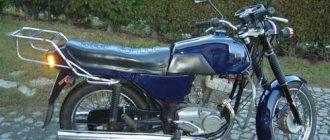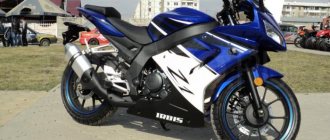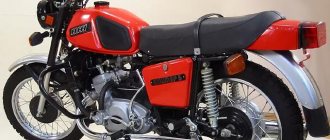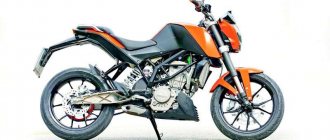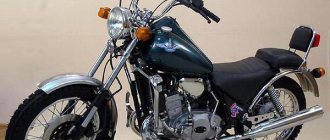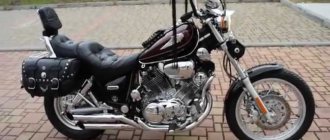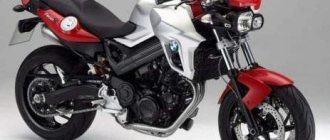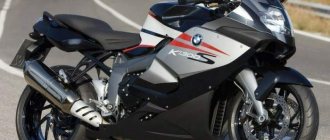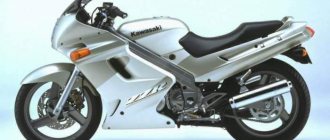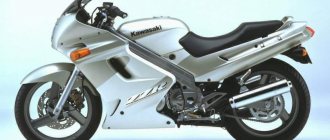After releasing models and (Respectively, liter and 600 cc versions) onto the market, the Yamaxa concern decided to replenish the line with a version for beginners. To create a good, budget sportbike, but with a small cubic capacity. Make the same R1, but with the expectation that novice motorcyclists will buy it.
The idea turned out to be successful and in 2008 the line was replenished with a small-capacity model - R125 . A small-capacity sports motorcycle aimed at European markets is the Yamaxa YZF-R125. Adjusted for the smaller engine capacity, most solutions are transferred from the “big brothers” .
With minor changes in terms of safety, the release of the model continues. The motorcycle underwent a major restyling only once - in 2014. Based on the bike, another model of the concern is produced, and the engine, redesigned during the restyling process, became the main one for the other two bikes.
Technical specifications (Power plant)
Beneath the plastic of the motorcycle lies a single-cylinder, water-cooled engine.
The model, designated by marketers for 2021, has additional functions both in the engine and in the chassis.
VVA. The electronics of the new bike have the ability to change the valve lift height (power stroke) as the speed changes. This gives a smoother, but noticeable increase in power.
Otherwise, it is a regular 4-stroke engine with 1 cylinder.
- working volume - 124 cm3;
- power - 15 hp;
- number of valves - 4;
- cooling - liquid;
- fuel supply - injector;
- ignition - digital (TCI);
- start - electric starter, kick starter foot present;
- Tank volume - 11.5 l.
Transmission and clutch
The bike has a 6-speed gearbox. The Assist & Slipper clutch system, announced in the new version, is simply called a slipper clutch in other models.
The rear wheel drive is a classic chain drive.
The gearbox works well , the gears shift smoothly, and the pedal travel is within acceptable limits.
- Multi-plate clutch , oil bath, power transmission - cable.
- The main drive is standard, chain .
Brakes
The motorcycle is equipped with disc hydraulics. During the development process, the 2-piston front caliper was replaced with a 4-piston one, with radial arrangement of working elements.
Front brakes.
Rear brakes.
Front: brakes:
- number of disks - 1;
- diameter - 392 mm;
- support - 4- (2-) piston.
Rear brakes:
- number of disks - 1;
- diameter - 230 mm;
- support - 1-piston.
Starting in 2015, ABS began to be optionally installed at the customer’s choice - only front, only rear, both at once. From 2021, the system is supplied as standard.
MY MOTORCYCLE
Look at him: just one look gives you goosebumps. This is a cool sportbike, it would be great to ride it. But no matter how much you want, it won’t really work out. Why? Yes, this Yamaha was created for motorsports, but for beginners. This tank is for those who dream of big motorsports, but have not yet saved up the funds or do not have the skills to ride a Supersport class motorcycle with an engine capacity of 600 cubic centimeters or more. The Yamaha YZF-R125 was specially created by engineers as an entry-level sports bike. But it all started wrong: when the company announced its intention to expand the line of sports motorcycles with another model, motorcycle fans all thought that Yamaha was creating some kind of monster, which in terms of engine power and speed characteristics could surpass the flagship of the model line and multiple winner of numerous Yamaha competitions YZF-R1.
Experts speculated that the engine capacity of a newbie should be at least 1250 cc - then it would simply have no equal. They were wrong by exactly 1125 cubic centimeters.
The new product, which Yamaha first introduced in 2008, simply amazed many. Instead of a sports monster, what appeared from under a bright blanket at the official presentation ceremony was not a super-fast sports bike, but the youngest representative of the company’s sports family - the Yamaha YZF-R125. And although its fast body kit is quite ambitious and largely replicates the appearance of its older brothers R6 and R, hidden under the plastic is an engine with a capacity of only 124.6 cm3. The new product did not compete with those who were expected - a new rival appeared in the Honda CBR125R and even the Kawasaki Ninja “four”.
However, the latter, due to the enlarged engine, will still not leave the youngest sports Yamaha a chance to win, although sometimes it’s still worth competing. Much depends on the skill of the biker!
And in general, the Yamaha YZF-R 125 engine is not at all as consumptive as it might seem at first. It is a single-cylinder, liquid-cooled powerplant with four valves and a single overhead camshaft. The piston stroke length in it exceeds the diameter of the cylinder - the dimension is 52 by 58.6 mm. At the same time, the engine is capable of producing almost 15 horsepower at the tachometer mark of 9000 rpm. It is not surprising that with such characteristics, some craftsmen manage to accelerate to quite serious speeds on this entry-level sportbike.
The body elements are assembled and fit together quite neatly, but some details are clearly borrowed from other Yamaha motorcycle models
By the way, the designers also made sure that the driver felt confident in corners. It is for these purposes that the rigid steel Deltabox frame served as the basis of the bike. Approximately the same one is used on the R1 and R6 models, with the only difference being that it is made of aluminum. But their younger brother boasts a lightweight swingarm made of “winged” metal and a reliable telescopic fork with a working stroke of 129.5 mm. The rear monoshock absorber travel is 124.5 mm, while the suspension has no adjustments either at the rear or at the front. However, adjustments on this motorcycle are completely unnecessary - it behaves perfectly both on winding country roads and in dense city traffic, confidently taking turns and changing lanes between cars. The only thing that the owner of a Yamaha YZF-R125 will miss after the first few trips is confident traffic light starts - the engine power is still not enough for fast acceleration. But you don’t need to ask much from the little guy! He is so good!))))
But the developers did not skimp on the brakes. A motorcycle weighing 127 kilograms, of course, doesn’t need a serious double-disc braking system, so one disc is installed on the front and rear wheels, but they are compressed by reliable Brembo calipers, which, if necessary, will stop the R125 much faster than the hot R6, and even more so R1. By the way, in terms of size, the Yamaha YZF-R125 is almost as good as its older brothers. It's slightly narrower and just a couple of centimeters shorter than the Yamaha R6, but has slightly higher ground clearance. On the track, it could easily be confused with other Yamaha athletes, if not for the excessively high pitch of the sound from the exhaust system and a very noticeable dip in acceleration dynamics after 90 km/h.
Upon closer examination, of course, one can also identify such unpleasant moments as spare parts that are clearly borrowed from other motorcycles, for example, the footpegs are exactly the same as on the Yamaha WR250X motocross bike. The brake and clutch levers cannot be adjusted to suit you in any way, and the same, as we have already said, applies to the suspension. But by and large, these are little things that you shouldn’t find fault with. Of course, the designers saved some money, but they managed to create an excellent bike that is perfect for teenagers who are interested in motorsports and often spend time on the training track. Moreover, if the owner likes it, he will immediately “adjust” the bike to suit himself. Nowadays this is possible!
Also, the Yamaha YZF-R125 will be an excellent option for economical bikers - the fuel consumption on this motorcycle does not exceed 3 liters per hundred kilometers, and of course this is the optimal model for practicing control skills - after several falls, cadets will especially appreciate its light weight, thanks to which They will be able to finish the motorcycle school without injury. Yes, and outwardly he doesn’t look like 125 cubes and I think no one would be ashamed to show off on him!
Yamaha YZF-R125, technical specifications:
| Maximum speed | 120 km/h |
| Power | 14.6 l. With. |
| Torque | 12 Nm |
| Weight | 127 kg |
| Seat height | 818 mm |
| Fuel tank | 13.8 liters |
| Average fuel consumption | 4.5 liters per 100 km |
| Engine | 124 cm3, four-stroke, 4 valves, liquid cooling |
| Transmission | 6 speeds |
| Front brake | Brembo, 292 mm disc, 2-piston caliper |
| Rear brake | disc 230 mm, caliper with 1 piston |
| Front tire | 100/80-17 |
| Rear tire | 130/70-17 |
based on materials from smotorom.ru
Dimensions and weight
The changes that are constantly being made in the design of the motorcycle do not affect the external parameters, with the exception of the 2014 restyling, when almost all the dimensions changed in one direction or another, and the weight increased.
Light weight makes the model optimal for teaching motorsports to beginners.
The curb weight for the first generation motorcycle was only 138 kg . After restyling, the bike began to weigh 140 kg .
When ABS appeared in the stock configuration - 142 kg .
Dry weight is 11 kg less.
The bike has the following dimensions:
- length - 1,956 mm ;
- width - 681 mm ;
- in height - 1,066 mm .
Seat height - 824 mm .
Wheelbase - 1,354 mm .
Ground clearance - 156 mm .
Chassis and brakes
The Brembo brakes here work great. But it is important to understand that in relation to the engine and the weight of the bike, they are so powerful that without proper self-control you can over-brake. There is one brake disc installed both front and rear, only it is larger at the front of the bike. The rear caliper is single-piston, while the front caliper is four-piston.
For the pendulum suspension with a monoshock absorber, the preload can be adjusted, and the stroke of this element is 114 mm. The travel of the 33 mm telescopic fork was 130 mm, and since 2014 it was replaced by an inverted fork measuring 41 mm, the travel remained the same.
For whom is it intended?
The rather low seating position typical of a sports motorcycle means that the biker should not be tall.
The Yamaha YZF-R125 is a real find for those who just want to try themselves in motorsports and do not yet have good riding skills.
In the case of this model, the developers guaranteed comfortable control for people up to 175 mm . Taller people may have trouble bending their legs (to get them onto the pegs) or turning the handlebars fully (the grips push into the knees).
Brief history of the model
- 2008 - start of production and sales. First generation.
Model
: Yamaha YZF-R125 (Europe).
Factory designation
: 5D71.
- 2009 - no significant changes.
Model
: Yamaha YZF-R125 (Europe).
Factory designation
: 5D72, 5D75.
- 2010 - no significant changes.
Model
: Yamaha YZF-R125 (Europe).
Factory designation
: 5D74.
- 2011 - no significant changes.
Model
: Yamaha YZF-R125 (Europe).
Factory designation
: 5D77.
- 2012 - no significant changes.
Model
: Yamaha YZF-R125 (Europe).
Factory designation
: 5D7B, 5D79.
- 2013 - no significant changes.
Model
: Yamaha YZF-R125 (Europe).
Factory designation
: 5D7F, 5D7J.
- 2014 - restyling of the model. Second generation.
Model
: Yamaha YZF-R125 (Europe).
Factory designation
: 5D78, 5D7K.
- 2015 - appearance of modifications with ABS.
Model
: Yamaha YZF-R125 + ABS (Europe).
Factory designation
: 5D7R, 5D7P, 5D7M + 5D7N, 5D7E.
- 2016 - no significant changes.
Model
: Yamaha YZF-R125 + ABS (Europe).
Factory designation
: 5D7W, 5D7S + 5D7X, 5D7T.
- 2017 - ABS is standard.
Model
: Yamaha YZF-R125 ABS (Europe).
Factory designation
: BR61.
- 2018 - no significant changes.
Model
: Yamaha YZF-R125 ABS (Europe).
Factory designation
: BR62.
- 2019 - restyling of the model. Third generation.
Model
: Yamaha YZF-R125 ABS (Europe).
Factory designation
: B5G1.
- 2020 - no significant changes.
Model
: Yamaha YZF-R125 ABS (Europe).
- 2021 - no significant changes.
Model
: Yamaha YZF-R125 ABS (Europe).
- 2022 - the appearance of a limited anniversary version of the Yamaha R125 World GP 60th Anniversary Edition in Yamaha's signature racing colors.
Model
: Yamaha YZF-R125 ABS + World GP 60th Anniversary Edition (Europe).
Modifications
The motorcycle has no direct modifications. But in 2014, Yamaxa offered the MT-25 . This naked bike is based on the R125 and is a stripped down version of the sport. All plastic has been removed . There were no changes in the characteristics of individual components.
The Yamaxa MT-25 is a stripped-down version of the YZF-R125 sports model.
And also the bike’s engine received an enduro version of the Yamaxa WR125R , and a motard assembled on the enduro basis - the Yamaxa WR125X .
Exterior
The appearance of the Yamaha YZF R125 motorcycle gives the impression of swiftness, as a machine of this class should have.
The exterior design is based on the contours of a lightweight delta-shaped frame, which ends with a long swingarm suspension at the rear and a telescopic fork at the front. On the latter, instead of a conventional wing, special carbon fiber modules are installed, covering the upper part of the front wheel.
The exterior of the Yamaha YZF R125 is dominated by a front shield with integrated optics in the form of two elongated headlights, as well as a “humpbacked” fuel tank, which, in addition to its main purpose, plays the role of a supporting element - the motorcyclist rests on it to reduce air resistance when driving at high speed .
Below the front flap is the main aerodynamic module, made of durable reinforced plastic, which takes on all the pressure of the oncoming air flow, cuts it and takes it back. The resulting turbulence is minimal. In strong side wind gusts, the motorcycle begins to yaw, but overall it has good directional stability.
The overall picture is completed by a rather large and heavy cylindrical muffler, which certainly affects the alignment of the motorcycle. Catalysts are built into its body, neutralizing harmful emissions and significantly reducing CO2 levels. The muffler ensures that the engine operates in an environmentally friendly mode according to the Euro-4 standard.
And as the final touch to the appearance of the two-wheeled car, there is a high-mounted double seat, with its tip pointing almost to the sky. Since the motorcycle is, in principle, considered a single-seater, the passenger seat is purely conventional and part of the design.
On the steering wheel there is a stylish instrument panel that combines both digital and analogue gauges. All vital signs are reflected on easy-to-read dials. To save space, the motorcycle's speedometer is combined with a tachometer. On the right side of the dial, the red sector of critical engine speed is indicated, which occurs after 11 thousand rpm. If the arrow reaches the warning zone, it is necessary to reduce the speed to a safe level.
Flaws
- Price . Despite the small cubic capacity, the new bike costs no less than the flagship R1.
- Hard sofa . It’s perfect for traveling on tracks, but driving somewhere far away is problematic.
- Low power . Motorcycle for one season. After which you want something more.
- Dynamics. More than 15 seconds for sports is not even interesting.
and dignity
Both ordinary motorcyclists and professional racers note the machine’s high reliability, efficiency and good driving characteristics for its class.
- Ideal for learners/beginners.
- Excellent handling.
- Low fuel consumption.
- Good maneuverability.
- Appearance is no worse than the flagship.
- Brembo brakes .


